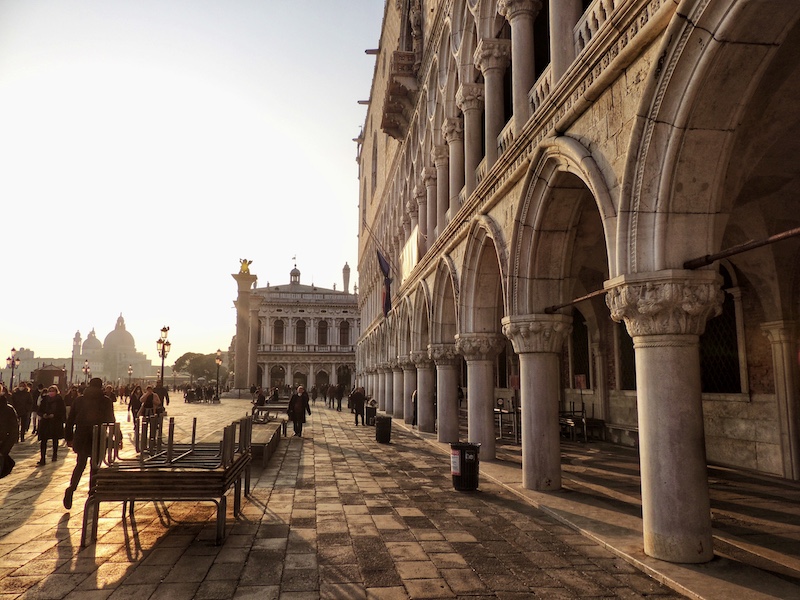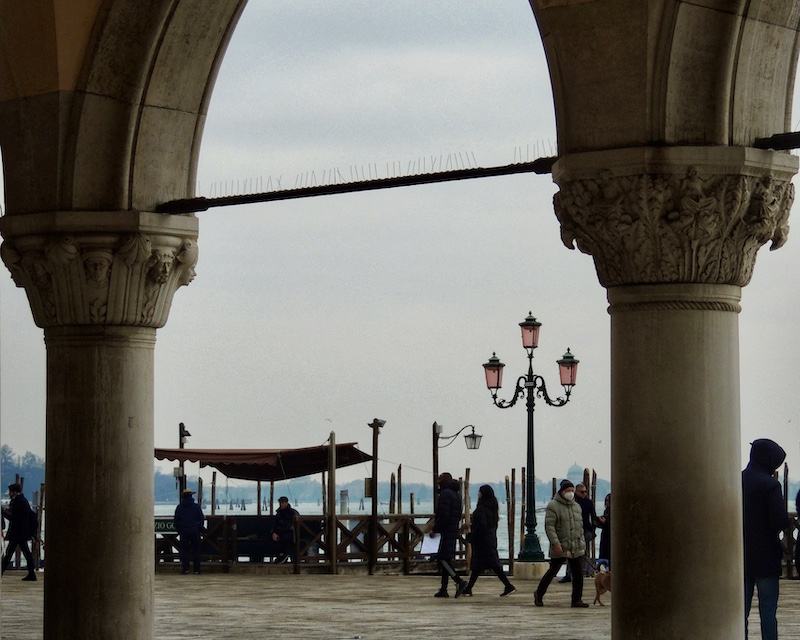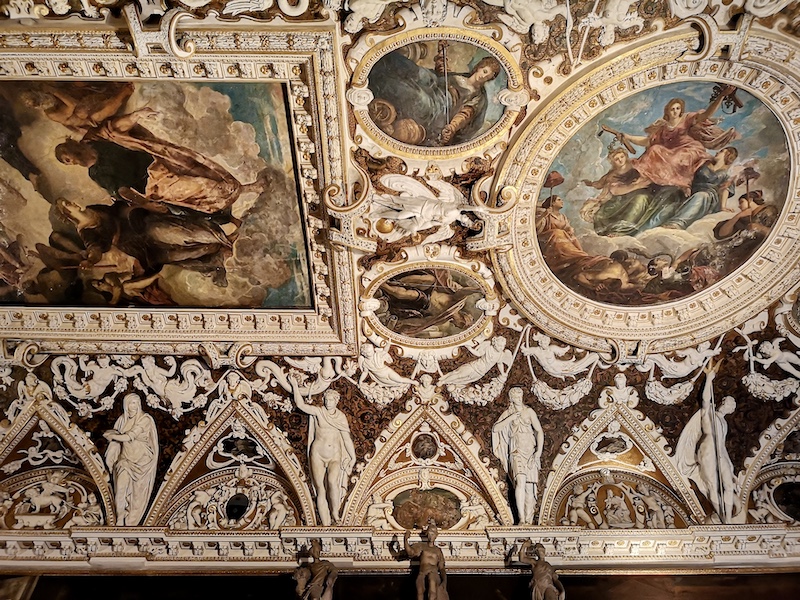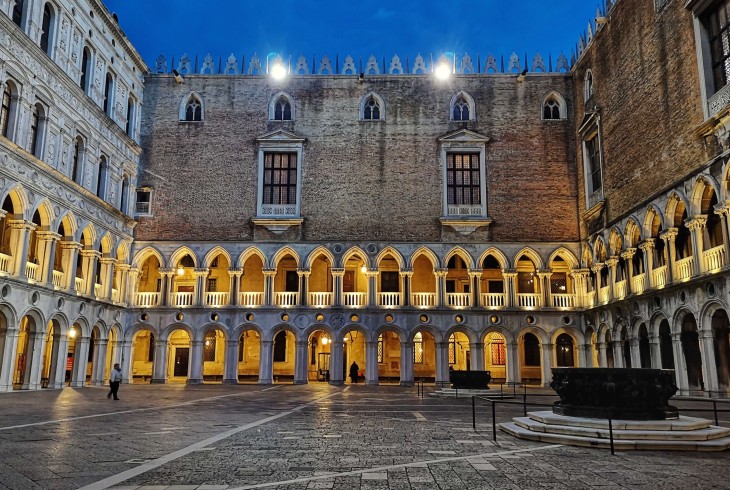Welcome to the Doge’s Palace, an architectural marvel and historical gem at the heart of Venice. For centuries, this magnificent structure - known in Italian as the Palazzo Ducale - served as the political and judicial center of the Venetian Republic. From its stunning Gothic exterior to its richly decorated interiors, the palace offers an unforgettable glimpse into Venice's glorious golden age.
In this guide, we’ve gathered together everything you need to know to make the most of your visit, including essential information on tickets and opening hours, must-see highlights, whether you should take a tour, and how long you need to devote to exploring the palace.
Get ready to uncover the secrets of one of Venice’s most extraordinary landmarks with us!
Why should you visit the Doge's Palace?
The Doge’s Palace is one of Venice’s most iconic landmarks, and a must-see for anyone visiting the city. Perched majestically on Venice’s southern waterfront, the Doge’s Palace is a striking symbol of the city’s rich history and architectural splendor. For centuries, this was the seat of the Venetian Republic’s rulers - the Doges - who governed the maritime empire from within the opulent walls of this spectacular Gothic Palace.
Visiting the Doge’s Palace offers a fascinating glimpse into a golden age of Venice where power, art, and intrigue intertwine. If you want to understand the history of the city, you need to come here.
The grand halls and chambers of the Doge’s Palace provide a spectacular showcase for some of the finest masterpieces of Venetian art. Great painters like Titian, Tintoretto, and Veronese were called on to decorate the building, providing a fitting backdrop to the high-stakes world of Venetian statecraft and the well-oiled bureaucracy that made Venice one of the most powerful republics in the world.
While the ceremonial rooms and lavish chambers are dazzling, the darker side of the palace is equally intriguing. A walk through the palace’s eerie prison cells - connected by the hauntingly beautiful Bridge of Sighs - reveals a different story, and reminds us that for all its lavish luxury, early-modern Venice was a dangerous and often brutal place.
A Brief History of the Doge’s Palace

The first structure built on the site was in the 9th century, an imposing fortress that kept the Venetian ruling classes safe from attack. In 1340, Doge Bartolomeo Gradenigo determined that something much grander was required, in keeping with the rapidly increasing prosperity of Venice. During this building campaign the fabulous pink and white marble facade facing the lagoon was created.
In the 1420s, under Doge Francesco Foscari, the palace was expanded with the creation of the wing facing St. Mark's Square, housing the Sala del Maggior Consiglio, where the Venetian Senate met. Superb Renaissance additions were commissioned in the late 15th and 16th centuries, including the stunning courtyard featuring Antonio Rizzo’s Scala dei Giganti.
Still later, a series of beautiful additions were made by the architect Antonio da Ponte, including the iconic Bridge of Sighs.
How do I get to the Doge's Palace?

The Doge's Palace is located just off Saint Mark’s Square. The grand piazza is right in the heart of Venice, so you’ll be able to walk here from most other parts of the city. If you are coming from the Santa Lucia train station it’s about a 30-40 minute walk, and you’ll pass through some of the loveliest areas of Venice. Saint Mark’s Square is about 10 minutes walk from the Rialto Bridge.
Once in St. Mark's Square, you’re almost there! The Doge's Palace is located on the southeast corner of the Piazza. Walk around to the right of St. Mark's Basilica towards the water’s edge, and look for the unmistakable arcaded pink and white facade of the Doge’s Palace.
You can also reach the Doge’s Palace via vaporetto (water bus). The closest vaporetto stop is San Zaccaria, served by lines 1, 2, or 5.1. From the stop, it's a short walk along the waterfront and through the square to the Ducal Palace.
What are the opening hours of the Doge's Palace?

- From April 1st to October 31st the Doge’s Palace is open from 9am to 7pm, with last entry at 6pm.
- From November 1st to March 31st, the Doge’s Palace is open from 9am to 6pm, with last entry at 5pm.
- From the 1st of May until the 30th of September, the Palace opens until 11pm on Fridays and Saturdays (last entrance at 10pm).
- Check the Doge’s Palace official website to keep up with any changes to these times.
How much do tickets to the Doge's Palace cost?

There are multiple different ticket options for the Doge’s Palace, depending on when you book and what itineraries you wish to include:
- Full Ticket: €30
Advance Purchase (booked online at least 30 days in advance of your visit): €25
- Reduced Ticket: €15 (for ages 6-25 with student ID, and seniors 65+)
Advance Purchase (booked online at least 30 days in advance of your visit): €13
- Museum Secret Itineraries Tour: €32
Museum Secret Itineraries Tour Reduced Ticket: €20
Children under the age of 5 visit for free. For more categories that qualify for free entry, see the full list here: Palazzo Ducale Ticket Prices.
Should I buy tickets to the Doge's Palace in advance?
It is definitely worth it to buy your tickets online in advance. Not only are the advance tickets cheaper if you book 30 or more days ahead of your visit, you’ll also be able to skip the lines for the ticket office, which can be long in high season.
Alternatively, you can join a tour that includes the Doge’s Palace. This will also include skip-the-line entry. More on that below.
Is it worth taking a tour of the Doge's Palace?

In our opinion, it’s well worth taking a tour of the Doge’s Palace. Whilst the palace is fascinating and beautiful to visit on your own, taking a guided tour offers a much richer experience. With a guide, you'll gain deeper insights into the history, art, and politics that shaped Venice as a powerful maritime republic, helping to place the Doge’s Palace in its context. You also won’t need to worry about organizing the practicalities of your visit yourself.
The Doge’s Palace is an enormous complex, and it can be hard to know what to focus on when inside. A knowledgeable guide will not only make sure that you see the best parts of the Palace, they’ll also help bring to life the sweeping halls and opulent chambers with dramatic tales of the scandals and intrigues that were rife in the Venetian halls of power.
The Doge’s Palace is a key site on Through Eternity’s Essential Venice Tour, where we visit the spectacular palace along with St. Mark’s Basilica and other unmissable city sites. For more information, click here: Essential Venice Tour.
How long should I spend at the Doge's Palace?
You should plan on spending an hour at the bare minimum in the Doge’s Palace. This will be enough time to walk through the complex and stop at some of the most important places like the Bridge of Sighs, the Grand Council Chamber and the Doge's Apartments.
We think you would be wiser allowing for 90 minutes to 2 hours to allow you to get a full sense of the palace, however, including stopping off to read the information boards that will provide context for the rooms you visit. If you are an art-lover and want to examine the array of artistic masterpieces on display in the Doge’s Palace, you may find yourself taking even longer.
What to See at the Doge’s Palace

There is an awful lot to see at the Doge’s Palace! Below is our guide to the highlights that you need to look out for on your route through the museum:
- The Grand Council Chamber (Sala del Maggior Consiglio)
Venetian nobles gathered in this massive, breathtaking hall to discuss the most pressing issues of state. It’s one of the largest rooms in all of Europe, and is decorated with stunning paintings by the finest Venetian artists - Tintoretto chief amongst them. Look out for his jaw-dropping Paradiso, which covers the entirety of the chamber’s eastern wall.
- The Golden Staircase (Scala d’Oro)
Designed by the renowned architect Jacopo Sansovino in the 16th century, this lavish gilded staircase was the stunning formal entrance to the Doge’s apartments for visiting dignitaries, leaving no doubt about the all-encompassing power of the Doge himself.
- The Doge’s Apartments
Once home to the elected rulers of Venice, this suite of rooms is decorated with portraits of the doges, delicate stuccoes and ceiling frescoes. Look out for the Sala dello Scudo, which features painted maps of the early-modern world showcasing the wide reach of the Venetian empire.
- The Chamber of the Council of Ten (Sala del Consiglio dei Dieci)
This room was where the powerful Council of Ten made decisions about pressing questions of public order and national security - often involving espionage and trials of suspected spies. The wood-paneled room is decorated with beautiful frescoes.
- The Bridge of Sighs
Connecting the Doge’s Palace to the forbidding prisons across the canal, this iconic bridge owes its romantic name to the despairing sighs of prisoners as they glimpsed the beauty of Venice from the narrow-slit windows as they made their unwilling way towards confinement.
- The Armoury
The armory was where the palace’s weapons, artillery, swords, armor and other military equipment was stockpiled, and the beautifully displayed collection offers a fascinating insight into Venice's military history.
- The Prisons
The labyrinthine warren of cells located deep in the Doge’s Palace complex was where undesirables of all kinds were kept awaiting trial in squalid conditions. The worst of the cells were known as pozzi, often half-flooded with water. In a bid to improve conditions, a new prison complex was built in the 16th century, which is what you can visit on a tour of the Doge’s Palace.
We hope you enjoyed our in-depth guide to visiting the Doge's Palace in Venice! If you want to take the stress out of planning your visit, consider our Essential Venice tour where we visit the Doge's Palace alongside St. Mark's Basilica and other city highlights.
MORE GREAT CONTENT FROM THE BLOG:
- Everything You Need to Know to Visit Venice
- Your Perfect One Day Venice Itinerary
- Where to Stay in Venice
- What to Do on Your First Trip to Venice
- How to Visit St. Mark's at Night
- 10 Romantic Things to do in Venice
- The Amazing Islands of Venice
- 10 Dishes You Need to Try in Venice







